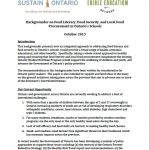Student Nutrition Programs and Procurement Targets Major Focus at Local Food Act Committee Hearing
Posted: October 28, 2013
Categories: Edible Education Network / Good Food Ideas for Kids / GoodFoodBites / News from Sustain Ontario

Sustain Ontario’s submission to Committee on Social Policy. Click here for full PDF.
1. Education Emphasized in Local Food Act Committee Hearings
As previously reported by Sustain Ontario, the Local Food Act has now reached committee and hearings have begun. On October 22nd, the Standing Committee on Social Policy held a second round of hearings allowing various organizations to voice their views on potential amendments to the Act. Each organization, Sustain Ontario among them, was provided with five minutes to present their views, which was in turn followed by three minutes of questioning from each party in the House. A collection of submissions to the Committee made by Sustain members can be viewed here.
Aside from Sustain Ontario, presenters included the Fruit & Vegetable Growers Association of Ontario, the Christian Farmers Federation of Ontario, the Greater Toronto Area Agricultural Action Committee, the Ontario Apple Growers, the Organic Council of Ontario, Dieticians of Canada, and the Alliance of Ontario Food Processors. Transcripts of the first hearings, held on October 8th, can be found here.
Two major themes seemed to run consistently throughout the presentations and questioning, namely the urgent need for student nutrition programs and food skills training in Ontario’s schools and the need for procurement targets establishing goals for how much food purchased by public institutions must be local.
Views surrounding the issue of student nutrition programs and food skills training were near unanimous, both among the presenters and government officials present at the hearing. It was generally agreed upon, as put forward by the representative from the Ontario Fruit & Vegetable Growers Association, that people simply will not buy what they do not know how to use. Creating strong food skills among students through community garden programs at schools, integrating cooking training into the curriculum as well as teaching students how to read and understand labels and the supply chain were repeatedly lauded as integral in creating a brighter food future in Ontario.
2. Setting Procurement Targets

Sustain Ontario’s Education Backgrounder. Click here for full PDF.
More contentious in the hearings, however, was the matter of procurement targets. The lack of explicit targets in the Act as it stands led some presenters to label it as purely aspirational. The MPPs present from each party repeatedly posed questions to presenters asking them what targets they would like to see included in the Act.
While some argued that setting targets would be overreaching by forcing organizations to report their progress every year, most seemed to agree that targets were necessary to ensure that the Act was truly effective in bolstering Ontario’s local food producers and that targets needed to be increased every year. Nonetheless, all were hesitant to throw out numbers.
Indeed, setting specific procurement targets is a complex matter, but it is not impossible. A report by Ecology Action examined the amount of dollars being spent on local food in the province of Nova Scotia and the impact of these figures on social and economic benefits as well as the environment. Finding that approximately 13% of food dollars were going back to Nova Scotia farms, a drop from previous years, the report concluded that at least 50% of purchasing dollars can be directed at local foods.
Targets were determined through examining key factors such as reducing the distance that food travels from farm to fork as well as ensuring that farmers in the province could secure a viable income. As stated in the report, “to have farms in this province, food needs to be purchased in a way that ensures farmers can recoup their costs of production. If our farms disappear, we won’t have the option to buy local food, which leads to higher prices for imported food, as well as a loss of food sovereignty (p.5).”
The report concludes:
To have a healthy and robust food system in this province, it would be better to have at least 50% of the provincial food dollars spent find their way back to farms. This would mean that farm income from domestic food sales would be $1.3 billion instead of the estimated $350 million. If we multiply that by the employment multiplier from Roberts et al (2005), that would generate 16,285 full time equivalent jobs.
The example of Nova Scotia is worth exploring in depth in order to set procurement targets within Ontario based on certain key benefits such as cutting emissions based on the distance food travels in getting to our plates, ensuring that farmers can secure a viable income, and creating more jobs in Ontario. Beginning with these principles and the goal of making Ontario more self-sufficient, targets for procurement can be set in accordance with key social, environmental, and economic objectives.
***
Keep up with developments related to the Local Food Act here.
